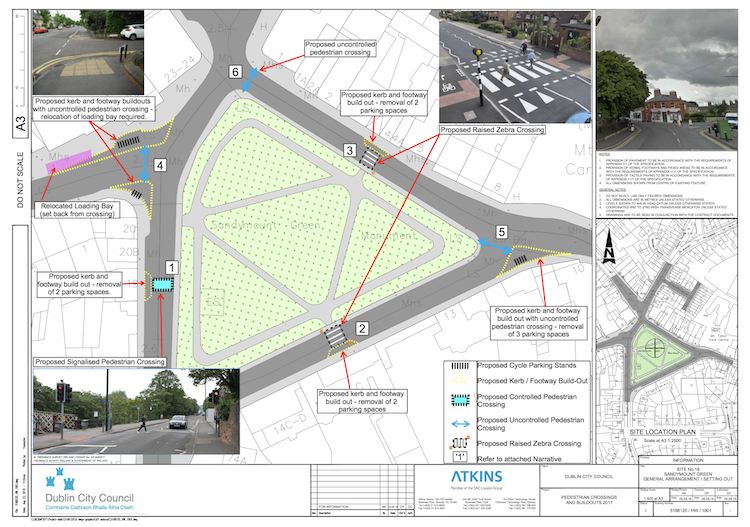What’s the best way to tell area residents about plans for a new asylum shelter nearby?
The government should tell communities directly about plans for new asylum shelters, some activists and politicians say.
At meetings at City Hall this week, councillors talked about changes in plans for how to use council land, possible traffic changes around Sandymount Green, and the roll-out of more “hubs” for homeless families.

Dublin City Council has 33 depots, which 1,400 council workers use as bases to run the city – whether overseeing road maintenance, waste management, public lighting, or other services that keep Dublin ticking.
When council officials put out proposals earlier this summer to sell off some of these depots, and use the funds to consolidate services into two super depots, some councillors responded with calls for more of the land to instead be kept for social and affordable housing.
Council officials have listened, said head of housing Brendan Kenny, at a meeting of the council’s housing committee last Thursday. “We are very conscious that in this day and age, with the housing crisis, that we just couldn’t just be selling of sites that could be used for social housing,” he said.
So, an updated report given to councillors on the committee sets out plans for 11 of the sites, rather than 6 of them, to be used for social or affordable housing – with room for roughly 557 homes.
But Dublin City Council Chief Executive Owen Keegan wants to merge most of these smaller depots into two larger ones – one on St Margaret’s Road in Ballymun and the other on Marrowbone Lane in the Liberties.
The issue has been how the new super depots will be funded. The Department of Housing funds social housing no problem, but doesn’t usually fund depots, Kenny said.
In this case, the department has said it may give a percentage of the land cost for each of the sites used for social housing, which could then be ring-fenced for the depots, he says.
The report suggests still selling three sites – at Kylemore Park South in Ballyfermot, in Cherry Orchard Industrial Estate, and on Slaney Road – as they are all zoned for industrial, and that’s an appropriate use there.
Councillors seemed happy that more sites would be used for social homes, and they wanted details on the timeline for the project.
“The first question we’re going to be asked is: when are they going to be build?” Fine Gael Councillor Ray McAdam said.
“The timelines are very difficult,” said Kenny. The timeline for the northside depot is 2020, and for the southside it would be three or four years after that.
“That put a bit of a downer on the whole thing, didn’t it?” said Sinn Féin’s Daithi Doolan, who is head of the housing committee.
Some councillors in the south-east if the city say they’ve been pushing for the best part of 25 years for changes to traffic around Sandymount Green.
Locals face speeding cars and buses, road space is tight, and pedestrians nip across streets without proper signals.
At Monday’s meeting of the council’s south-east area committee, Helen Smirnova, an executive engineer with the council, showed councillors a possible plan for traffic changes on the green to make it safer and easier for pedestrians to go to and from the grassy triangle at the centre of the village.

Those changes would include more pedestrians crossings, zebra crossings, and tweaks to road design to slow down traffic.
On the whole, councillors welcomed the plan. It should make the village area feel more like a village again, said Green Party Councillor Claire Byrne.
Fine Gael’s Paddy McCartan welcome the return of zebra crossings. “I thought zebra crossings have gone out of fashion,” he said.
If councillors back the plans and decide to press ahead, the changes would be rolled out gradually, says Smirnova. “It probably will take a few years before we implement every device to create a village atmosphere,” she said.
But there are funding issues to be settled. The council estimates that the changes would cost €200,000, and it could limit what other projects could happen in the south-east area, if they decided to spend on that.
That question was left hanging. The council still has to vote on the budget for the coming year, which has a “certain amount of buoyancy”, said independent Councillor Ruairi McGinley.
At the council’s housing committee, Sinn Féin Councillor Daithi Doolan asked if the council had made any progress on family hubs for homeless families.
Doolan said he was working with a woman who has been moved from hotel to hotel seven times. “Is there any [hubs] in the pipeline?” he asked council officials.
At the moment, in the Dublin region, there are 18 hubs with 465 “units”, according to the Dublin Region Homeless Executive.
Eileen Gleeson, the head of the Dublin Region Homeless Executive, said 96 new places in family hubs “will be in place by the end of this year”, in the four local authorities in the Dublin area.
There are 196 more possible places that they’re looking at across the Dublin area, too, she said.
On average, eight families presented each day to homeless services in July, and four of these ended up in emergency accommodation, Gleeson said.
Get our latest headlines in one of them, and recommendations for things to do in Dublin in the other.